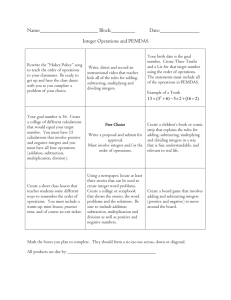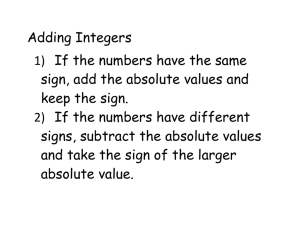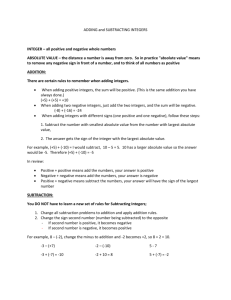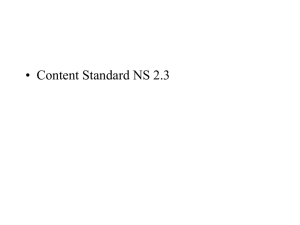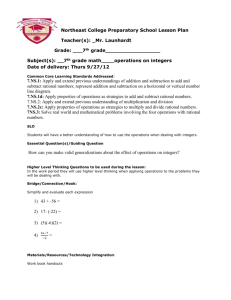Subtracting Integers
advertisement
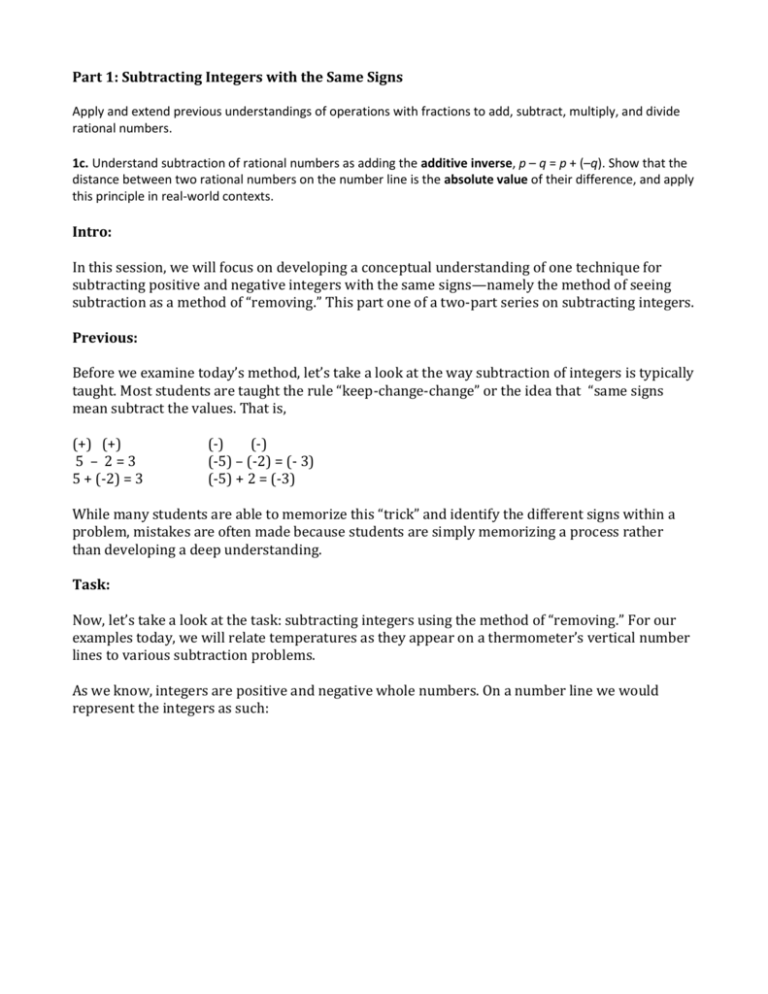
Part 1: Subtracting Integers with the Same Signs Apply and extend previous understandings of operations with fractions to add, subtract, multiply, and divide rational numbers. 1c. Understand subtraction of rational numbers as adding the additive inverse, p – q = p + (–q). Show that the distance between two rational numbers on the number line is the absolute value of their difference, and apply this principle in real-world contexts. Intro: In this session, we will focus on developing a conceptual understanding of one technique for subtracting positive and negative integers with the same signs—namely the method of seeing subtraction as a method of “removing.” This part one of a two-part series on subtracting integers. Previous: Before we examine today’s method, let’s take a look at the way subtraction of integers is typically taught. Most students are taught the rule “keep-change-change” or the idea that “same signs mean subtract the values. That is, (+) (+) 5 – 2=3 5 + (-2) = 3 (-) (-) (-5) – (-2) = (- 3) (-5) + 2 = (-3) While many students are able to memorize this “trick” and identify the different signs within a problem, mistakes are often made because students are simply memorizing a process rather than developing a deep understanding. Task: Now, let’s take a look at the task: subtracting integers using the method of “removing.” For our examples today, we will relate temperatures as they appear on a thermometer’s vertical number lines to various subtraction problems. As we know, integers are positive and negative whole numbers. On a number line we would represent the integers as such: Positive Negative We can also use a more pictorial model to represent both the positive and negative integers. For today’s purpose, we are going to use circles to represent our positive and negative values. Now, in the classroom you can use red and yellow color counters, slips of paper with plus and minus signs, etc. So let’s suppose a non-shaded circle is positive and has the value of +1, and shaded circle is negative and has the value of -1. =Positive =Negative Suppose on a brisk winter day the 5-degree weather fell two degrees. Given this scenario, we could derive the simple subtraction problem 5-2. We are beginning with an integer of positive 5, which can be represented using 5 non-shaded circles. We can think of the subtraction sign as the phrase “take-away,” so the problem would read, positive 5 “take away” positive 2. So to solve this problem, we are seeking to “remove” two positive, non-shaded circles from our group of 5. The first thing, you have to ask yourself is, “is this possible” and of course in this scenario, it is in fact possible. Once these 2 circles are removed, you can see that we are left with 3 non-shaded circles or positive 3. So, 5-2 = 3. Remove +2 On our thermometer, we could represent the temperature falling 2 degrees resulting in a final temperature of positive 3 degrees. Now let’s look at another problem. Suppose the winter became even more intense and a January morning posted a temperature of -5 degrees. As the morning progressed, the temperature lost negative two degrees. Given this scenario, you could ask your students if they thought the current temperature was warmer or colder than where it began at the beginning of the morning and of course asking why they thought so. This will help gage and pre-assess student understanding and provide a concrete foundation for students to build upon. From this scenario, we can begin with the problem (-5) – (-2). Thinking back to the last problem, we are now beginning with an integer of negative 5, which can be represented using 5 shaded circles. The problem can be articulated as negative 5 “take away” negative 2. Asking ourselves if we can “remove” 2 negative or shaded circles, we can conclude that the answer is yes. Once these two shaded/negative units are removed, we are left with 3 shaded circles or negative 3. So, (-5) – (-2) = -3. Remove -2 This can also be represented using our thermometer. We began with a temperature of -5 degrees as shown on the thermometer. We then lost two of those negative units, which causes our thermometer or temperature to rise to a final temperature of -3. While the diagrams pictorially represent the method of “removing”, we have yet to answer the overarching, potentially most important question as to why subtracting integers with the same signs implies subtraction of their absolute values, which is definitely a question you can ask your students as they complete such a task. To answer this question, we can think of this problem in terms of a strip diagram that depicts a part to whole relationship where -5 is the whole and the parts are -3 and -2. If we are beginning with -5, and taking away -2, we have to determine what value combined with -2 will give us a total of -5. In other words -2 plus what gives you -5. As shown in the strip diagram, we can clearly see the answer is -3. -5 (whole) (part) (part) (-3) (part) (-3) + (-2) = -5 (part) (Part) (-2) So, to wrap up, teaching subtraction of integers using a “removal” method helps provide students with a context and conceptual understanding first before learning the rules and procedures. This way, students develop a rich understanding of the mathematics, rather than a list of procedures and “tricks” that are likely to be forgotten or confused. Be sure to tune into the next “pencast” where we will explore how to subtract integers with opposing signs.


